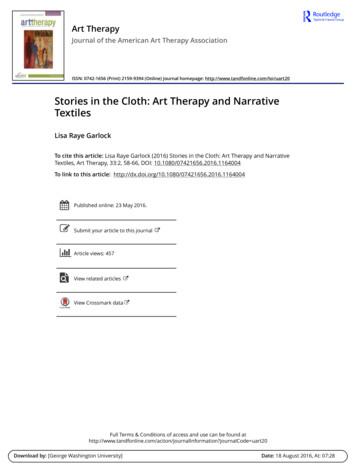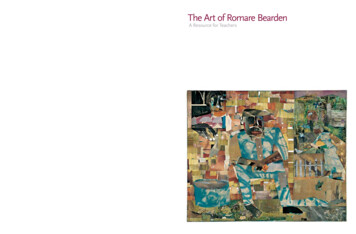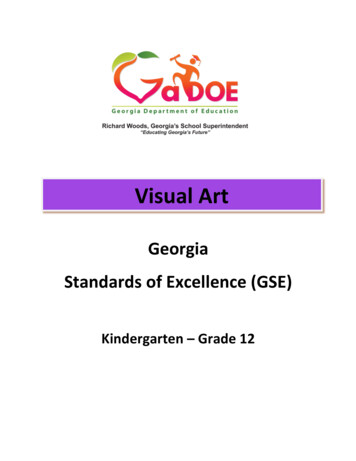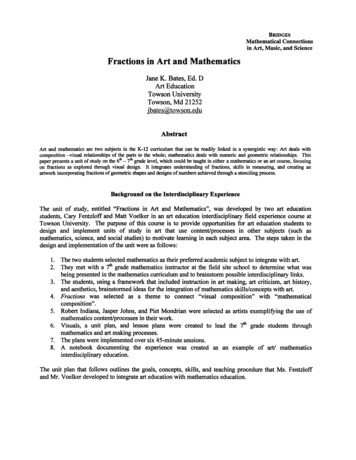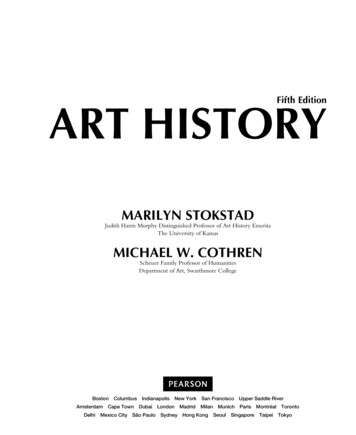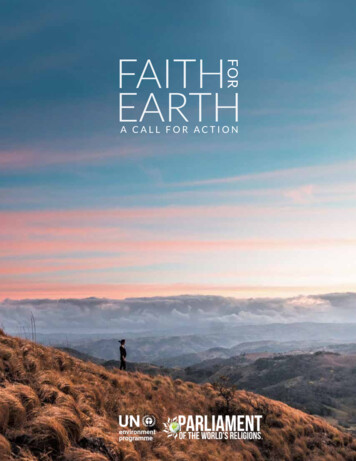
Transcription
FORFAITHEARTHA CALL FOR ACTION
2020 United Nations Environment ProgrammeFaith for Earth: A Call for ActionISBN No: 978-92-807-3802-5Job No: EO/2300/NAThis publication may be reproduced in whole or in part and inany form for educational or non-profit services without specialpermission from the copyright holder, provided acknowledgmentof the source is made. United Nations Environment Programmewould appreciate receiving a copy of any publication that uses thispublication as a source.D i s c l a i m ersThe designations employed and the presentation of the material inthis publication do not imply the expression of any opinion whatsoever on the part of United Nations Environment Programmeconcerning the legal status of any country, territory or city orits authorities, or concerning the delimitation of its frontiers orboundaries.Mention of a commercial company or product in this documentdoes not imply endorsement by the United Nations EnvironmentProgramme or the authors. The use of information from thisdocument for publicity or advertising is not permitted. Trademarknames and symbols are used in an editorial fashion with no intention on infringement of trademark or copyright laws.The views expressed in this publication are those of the authorsand do not necessarily reflect the views of the United NationsEnvironment Programme. We regret any errors or omissions thatmay have been unwittingly made.References to websites (URLs) in the printed book were accurateat the time of publication. The authors, editors, Parliament of theWorld’s Religions, and United Nations Environment Programmeare not responsible for URLs that may have expired or changedsince the manuscript was prepared. Maps, photos, and illustrations as specified.Cover: Guanacaste Province, Costa Rica. Photo by Miguel Bruna.Printed in the United States of America.United Nations Environment ProgrammeUnited Nations Avenue, Gigiri, Nairobi, Kenyahttps://www.unenvironment.orgParliament of the World’s Religions70 East Lake Street, Suite 230, Chicago, IL 60601 USAhttps://parliamentofreligions.orgS u g g es t ed c itat io nUnited Nations Environment Programme and Parliament of theWorld’s Religions (2020). Faith for Earth: A Call for Action.UNEP, Nairobi.FAITHEARTHFORNo use of this publication may be made for resale or any othercommercial purpose whatsoever without prior permission inwriting from the United Nations Environment Programme.Applications for such permission, with a statement of the purposeand extent of the reproduction, should be addressed to theDirector, Communication Division, United Nations EnvironmentProgramme, P. O. Box 30552, Nairobi 00100, Kenya.A CALL FOR ACTION
Preface 5Message from the Faith for EarthInitiative of the United NationsEnvironment Programme 6Message from THE Parliamentof the World’s ReligionsClimate Action 8The Earth Charter 10Faith 13Indigenous Traditions 15Judaism 21Christianity 27Islam 35Zoroastrianism 40The Bahá’í Faith 42Hinduism 44The Jain Religion 49Buddhism 53The Sikh Religion 57Confucianism 61Daoism 65Shinto 68Environmental Ethics: Points of AgreementAmong the World’s Religions 71Earth 73Land and Terrestrial Ecosystems 77Oceans 83Water 86Cryosphere 89Biodiversity 91Atmosphere 95People 97Conclusion 100The Fifth Directive 100Our Shared Future 101Appendices 102Authors and Editors 102Acknowledgments 102Faith References: Bibliography 103Earth Endnotes 104Websites and Resources 105Publication Credits 108To Readers of Printed Copies:URL addresses in the text connect to websites and interactivefeatures on the Internet. Please visit the online edition of this book ion/faith-earth-call-action h.
PrefaceThis book was first published at the beginning of the twenty-first century.A joint project of the United Nations Environment Programme and theInterfaith Partnership for the Environment, it was titled Earth and Faith: ABook of Reflection for Action. The partners printed tens of thousands of copiesand gave them to schools, congregations, and communities throughout theworld. The book described the growing threats to our planet’s life supportsystems, the reverence all faiths share for life on Earth, and the responsibilitythat people have to future generations.Teachers, students, leaders of religious congregations, and communityorganizers used the book to introduce and talk about critical environmentalissues and how faith communities were addressing these issues. Intendedprimarily as an educational resource, it has also been used as a reference andinspiration for practice.During the twenty years that have passed since the book’s publication,the planet has undergone profound and rapid changes. The impact of ouractions and choices continues to escalate, causing the ever-worsening globalclimate emergency, altering natural global processes and major ecosystems,accelerating extinctions of countless forms of life, and deepening human suffering on an unprecedented scale.Scientific evidence documenting the crisis is undeniable and growswith every passing day. At the same time, there has been a surge of faith-basedaction and advocacy on behalf of the environment from religious groups everywhere. The response is coming from every corner of the world, reflectingboth the diversity of the ways we define our relationship with nature and theessential unity of values at the core of all our hope.As we begin this century’s third decade, the new edition — producedthrough a partnership between the United Nations Environment Programmeand the Parliament of the World’s Religions Climate Action — offers an introduction to the magnitude of the task we now face and to the faith communities that are becoming a force for the global environmental future. Also, inkeeping with the urgency of the work that must be done to heal our planet, wehave changed the book’s title. It is time, as never before, to call on our faith,our values, our religious teachings and traditions – on Faith for Earth. And itis time for action.5
Message from the Faith for EarthInitiative of the United NationsEnvironment ProgrammeIam privileged to have this opportunity to welcome you to Faith for Earth,A Call for Action, the new, revised edition of Earth and Faith, last publishedtwenty years ago. It is an honor to have worked in partnership with the Parliament of the World’s Religions to produce this book.Faith for Earth describes the essential, unshakeable reverence that allreligions have for creation and nature, and provides an introduction to theworld’s major life support systems. I hope it will give you information andinspiration to learn more about our planet, to share your knowledge and commitment to care for it, and to become part of the flourishing global interfaithmovement that is increasingly bringing people together to protect and sustainlife on Earth.In the last 60 years, more than 40% of the world’s civil wars have beenlinked to control over natural resources such as land, oil, and water. Climatechange is on track to make this situation worse, with unprecedented new impacts on the functioning ecosystems we depend upon for survival, as well ason where people can live and grow food, build cities, practice their faith, andraise their children in peace and health. The security implications of climatechange are being recognized at the highest levels, and UN Secretary-GeneralAntónio Guterres has put it at the heart of our conflict prevention agenda.The Secretary-General announced in April 2020 that “the global crisiswe are facing today due to the COVID-19 pandemic is the gravest challengesince the establishment of the UN 75 years ago,” but it also remains an irrefutable fact that climate change continues to be one of the most systemic environmental threats that humankind has ever faced.We are in a race against time that will require political will, innovation,inclusion, tolerance, values and ethics, financing, and partnerships. We arecalling on everyone—countries, cities, the private sector, individuals, andfaith-based organizations—to strengthen their actions to mitigate climatechange, restore ecosystems, and protect the health of the planet without delay.The world has the scientific understanding, the technological capacity, and thefinancial means to do this. We need to trust our abilities and act accordingly.Let us adopt an integrated approach to tackling the cry of the planetand achieving sustainable development. The private sector is already takingvarious actions to ensure environmental sustainability through sustainabilitybudgeting and innovations. Many in the financial sector know that investingin a clean energy future and nature-based solutions will pay dividends.6We need to think about how we commute and about the sustainability of our houses and buildings. Are we encouraging means of mass transportation? Are we reducing the need to commute by encouraging workingfrom home and using smart phones and computers for transactions? Do ourbuildings produce their own energy? Do they recycle their own water? Arewe treating and recycling our waste and moving to adopt a circular economywith zero waste?Are we eating healthy food? Are we buying locally grown vegetables?Or are we importing off-season produce from countries that are thousands ofmiles away?Technology is on our side. Our challenge is not that we do not knowwhat to do—it is how quickly we can do it. The problem is massive, and suchlarge and complex challenges will require transformational thinking, integration, and big movements. But it will also require progress on myriad smallerand manageable scales. We need faith-based organizations to be part of theglobal accountability and monitoring system to achieve sustainable development goals, and we need a common ethical system of values no matter whatreligion we believe.I write this with hope and optimism because I am convinced that thelove for power and greed that led us to where we are today can be overcomeby the power of love, science, and faith.The UN has adopted Global Action for People and the Planet, its globalenvironmental agenda, through 2030, but the faith agenda is eternity. Ourconcern should not be the just next generation; it should be all generations tocome. We must make a global pact, on behalf of the natural world, to bringthe values of faith to the practices of people and decisions of politicians. Weneed to work with the environment to avoid new global catastrophes. I callupon all the faith communities in the world to lead by example and join ourCoalition in putting our Faith for Earth into action today.PracticingWhat We PreachFaith-based organizations own8% of the habitable land surface,5% of all commercial forests,50% of the schools in the worldand 64% of schools in subSaharan Africa, 10% of world’stotal financial institutions,and 14% of its communitydevelopment corporations.There are 37 millionchurches in the world with34,000 (Christian) denominations. The current number ofmosques in the world is around4 million. There are 20,000 synagogues and countless temples.Adapting these establishments to produce their ownenergy, reduce their carbon footprint, and extend these benefitsto neighboring communities willbe a massive demonstration ofpracticing what we preach.Iyad Abumoghli, Ph.D. Eng.Director, Faith for Earth Strategic Engagement with Faith-based OrganizationsExecutive Office United Nations Environment ProgrammeNairobi, Kenya7
Message from Parliament of theWorld’s Religions Climate ActionTwo decades into the 21st century, we know far more about the complexweb of forces and influences that determine the interconnected relationship between humans and nature than we did when the previous edition ofthis book was published in 2000. It is now indisputable that humans are aforce of geological proportions, one that is putting ever-increasing pressureon natural resources and ecosystems everywhere on Earth.1The dilemmas we face are unavoidable and grow more critical withevery passing year. If business as usual were capable of solving them we wouldnot have the poverty, the unequal distribution of wealth, the increased conflict and use of violence for political purposes, the environmental destruction,and the unsustainable patterns of production and consumption that surroundus today.In the last 20 years, each of these dilemmas has been dramaticallyworsened by the realities of climate change. We are proceeding headlong intoa future shaped by the discharge of our wastes into our atmosphere and ouroceans.The decades ahead present us with a crucible of moral choices.We are the first generation in human history that has had the opportunity to achieve sustainable and just societies. We have the knowledge, thetechnology, and the wealth to succeed. Moreover, for half a century, we haveknown that the choices we make will have serious consequences for the worldof the future and for our children. It is clear that most often we have lackedthe courage and the will to make the morally right choices, to do what weknow is necessary.Each and every one of us is responsible for the consequences of ourchoices. Each day that passes without our finding the courage to make thedecisions we know are necessary adds to the unconscionable burden webequeath to our children and grandchildren. The difficulty of the decisions weleave to them will far exceed the difficulty of the decisions we face today.Examples of faith-based environmental teachings and traditions in thefirst part of this book stand in direct contradiction to the human choices thathave written our crisis across the face of the planet. The reality that resultsfrom our refusal or inability to act is clear in its outline, and even in muchof its detail; an overview of the impact of our actions on the natural world isintroduced in the second half of the book.Today the voices of our children call out to us, challenging our cowardice and greed as they consider their legacy of emptiness, poverty, and violenceCourtesy of Nathaniel Hales.— but an even more dire fate awaits our grandchildren. We leave them aworld that our parents would not recognize, bereft of much of the beauty,complexity, and richness we have squandered. Our actions are poised to breakthe bond between grandparents and grandchildren; we will not recognize theworld in which we condemn them to live, and they will be strangers to thebeauty and bounty of the world our parents left to us.The context in which we will make our choices must include the fullpanoply of faith, science, and societal institutions. If these institutions are tobecome agents of sustainability, they will need to be enabled by knowledgeand inspired by faith.David HalesChair, Climate ActionParliament of the World’s Religions89
The Earth CharterTHE SACREDUNIVERSE“A recovery of the sublimemeaning of the universe couldlead both to a greater intimacy ofthe human with the manifestationof the divine in the natural worldand to a greater intimacy ofthe different religions amongthemselves. Restoration ofthe sense of the natural worldas divine manifestation has aspecial urgency because of thedevastation that we are presentlycausing to the natural world Only the religious forces of theworld with their sense of thesacred can evoke the psychicenergies needed to transform adeclining Cenozoic Era into theemerging Ecozoic Era To initiateand guide this next creativemoment of the great story of theEarth is the Great Work of thereligions of the world as we moveon into the future.”—Thomas Berry,The Sacred Universe, pp. 80-87.The mission of the United Nations Environment Programme and theParliament of the World’s Religions align with the principles and goalsarticulated in The Earth Charter (https://earthcharter.org/), an internationaldeclaration of fundamental values and ethical framework for building a just,sustainable, and peaceful global society in the 21st century. The Charter waslaunched in June 2000 by an independent international entity in a ceremonyat the Peace Palace in The Hague. It is the product of a ten year, worldwide,cross-cultural dialogue on common goals and shared values, and is the mostinclusive and participatory process ever associated with an internationaldeclaration. The Charter recognizes that the goals of ecological protection, theeradication of poverty, equitable economic development, respect for humanrights, democracy, and peace are interdependent and indivisible. It providesan inclusive, integrated ethical framework to guide the transition to a sustainable future, and has been endorsed by over 6,000 organizations, includingmany governments and international organizations.The Charter contains four basic principles, each of which includes a specificset of goals, commitments, and actions:9. Eradicate poverty as an ethical, social, and environmental imperative.10. Ensure that economic activities and institutions at all levels promotehuman development in an equitable and sustainable manner.11. Affirm gender equality and equity as prerequisites to sustainabledevelopment and ensure universal access to education, health care, and economic opportunity.12. Uphold the right of all, without discrimination, to a natural and socialenvironment supportive of human dignity, bodily health, and spiritualwellbeing, with special attention to the rights of Indigenous Peoples andminorities.IV. Democracy, Nonviolence, and Peace13. Strengthen democratic institutions at all levels, and provide transparencyand accountability in governance, inclusive participation in decision making,and access to justice.I. Respect and Care for the Community of Life14. Integrate into formal education and life-long learning the knowledge,values, and skills needed for a sustainable way of life.1. Respect Earth and life in all its diversity.15. Treat all living beings with respect and consideration.2. Care for the community of life with understanding, compassion, and love.16. Promote a culture of tolerance, nonviolence, and peace.3. Build democratic societies that are just, participatory, sustainable, andpeaceful.4. Secure Earth’s bounty and beauty for present and future generations.II. Ecological Integrity5. Protect and restore the integrity of Earth’s ecological systems, with specialconcern for biological diversity and the natural processes that sustain life.6. Prevent harm as the best method of environmental protection and, whenknowledge is limited, apply a precautionary approach.7. Adopt patterns of production, consumption, and reproduction thatsafeguard Earth’s regenerative capacities, human rights, and communitywellbeing.8. Advance the study of ecological sustainability and promote the openexchange and wide application of the knowledge acquired.10III. Social and Economic JusticeThe Charter asks that human beings “imaginatively develop and apply thevision of a sustainable way of life locally, nationally, regionally, and globally”;preserve cultural diversity; and work collaboratively in the search for truthand wisdom. It calls on the arts, sciences, religions, educational institutions,media, businesses, nongovernmental organizations, and governments to offercreative leadership, and asks the nations of the world to fulfill their obligations under existing international agreements and support implementation ofEarth Charter principles.“Let ours be a time remembered for the awakening of a new reverence for life,the firm resolve to achieve sustainability, the quickening of the struggle for justice and peace, and the joyful celebration of life.”YALE FORUM ONRELIGION AND ECOLOG YThe Yale Forum onReligion and Ecology (FORE),(https://fore.yale.edu) is aninternational multi-religiousproject contributing to thefield of religion and ecologyand is an engaged moral forceof religious environmentalism.Its mission is to inform andinspire people to preserve,protect, and restore the Earthcommunity. The religions ofthe world transmit ecologicaland justice perspectives intheir scriptures, rituals, andcontemplative practices, aswell as in their moral andethical commitments. FOREidentifies those perspectives inorder to share comprehensiveand collaborative solutions toglobal environmental crises,cultivating dialogue amongreligious/spiritual communitiesin partnership with scientistsand policy makers. Its websiteprovides a clearinghousefor news, information, andresources about religion andecology, highlighting over 300engaged projects.FORE works to nurture aflourishing Earth community,where religious and spiritualtraditions join together for theshared wellbeing of ecosystems,life forms, and people in ourcommon planetary home.Founded by Mary Evelyn Tuckerand John Grim at the UnitedNations in 1998 and based atYale University since 2006,FORE plays a pivotal part in thestudy of religion and ecologyand has had an instrumental rolein making the publication of thisbook possible.11
FaithDuring The World Wildlife Fund (WWF) International’s25th anniversary celebration in Assisi, Italy in September 1986, leaders of five of the world’s religions — Buddhism,Christianity, Hinduism, Islam, and Judaism — presentedstatements about their traditions’ understanding of nature andtheir religion’s values concerning conservation and the environment. Known as the Assisi Declarations, those five statements are regarded as a landmark in religious environmentalethics. WWF also launched the Network on Conservation andReligion at that time, leading to the formation of the Alliance ofReligions and Conservation (ARC). The Bahá-í Faith, Confucianism, Daoism, the Jain Religion, the Sikh Religion, Shinto,and Zoroastrianism joined ARC and created statements abouttheir faith’s relation to nature, and the Assisi Declarations themselves expanded to include additional detail. Each of the faithtraditions’ teachings in the following pages begins with briefexcerpts from the five Assisi Declarations, from the statementsby the seven religions that joined the ARC network, and froma declaration by the Alliance of Mother Nature’s Guardians,a group of Indigenous leaders and activists from around theworld, at their second assembly in 2017.Indigenous TraditionsThere are more than 370 million Indigenous Peoples living in70 countries on six continents, with unique cultures distinctfrom the dominant societies in which they live and long-standing connections to particular ancestral lands. The UnitedNations Permanent Forum on Indigenous Issues states that“.the most fruitful approach is to identify, rather than define,indigenous peoples. This is based on the fundamental criterionof self-identification as underlined in a number of human rightsdocuments.” Despite their diversity, the traditions of IndigenousPeoples share several common themes, including recognition ofthe community of all life, in which humans are just one member; respect for nature and other-than-human forms of life; theimperative of harmony with nature; and living in accord withoriginal instructions given by spiritual beings and the Creator.Abrahamic ReligionsJudaism, Christianity, and Islam agree that nature is God’s creation. God has made the universe and the order of the naturalworld, and has provided for all God’s creatures. These faithspress us to recognize that we are one small part of a complex,interdependent creation. And yet God has given humans aspecial responsibility to take care of and protect creation, asgood stewards or guardians. All beings in creation have value inGod’s eyes and should be treated with respect.Photoby Adam Dutton.12Indic religionsReligious traditions originating in India are Hinduism, theJain Religion, Buddhism, and the Sikh Religion. While theirworldviews differ, they share certain basic concepts, including belief in many births, or “reincarnation,” in which life cantake different forms, creating continuity between human lifeand other living things. Rebirth is determined in part by one’skarma, which may be ethically good, bad, or neutral. The wordkarma means “action,” and implies that every action has aresult, an important idea for ecological ethics. Indic traditionsaffirm that there is a right order of the universe and of humansociety, often called Dharma, a term of central importance inIndian civilization. Indicating universal moral norms, Dharmahas many possible translations, including “law,” “duty,” and“righteousness.” Indic religions also share systems of spiritualdiscipline and contemplative practice known cross-traditionally as Yoga or “union,” aiming at oneness with a sacred reality.East Asian ReligionsThe religions originating in East Asia are Confucianism, Daoism, and Shinto. Chinese civilization is at least 5,000 years oldand the roots of Confucianism and Daoism are very ancient.They share a worldview in which the universe is seen as a livingorganic whole, united by matter-energy (qi or ch’i). This vitalforce is the basis for dynamic change and creativity. The greattriad of Heaven, Earth, and Humans forms the unity of theuniverse. Within this triad, humans cultivate virtue, followingthe Way of the Sages. Confucian teachings on humaneness andfilial piety contribute to social and political harmony. Daoistteachings contribute to individual health and wellbeing. InJapan, the indigenous tradition of Shinto centers on the community of deities (kami) in the natural and human worlds.These deities are to be respected so that the natural world, infused with divinity and purity, will continue to sustain all life.Note: The pages that follow are guided by the concept that areligion has three aspects: a worldview or “cosmovision”; avalue system, or ethics; and a set of practices or “way of life”that attune the individual and the community to that worldview. A religious worldview (as distinct from a secular one)references a larger reality sometimes called the Sacred.We have consulted with community members fromeach religious tradition on the content of individual sections.We recognize that not all may agree on how a given religionshould be named, and have tried to be respectful of differentpoints of view.We have made slight revisions in a few places in wording to accommodate gender-inclusive language.13
Indigenous TraditionsCourtesy of allianceofguardians.org.We, Guardians and Children of Mother Earth, IndigenousPeoples and allied partners, held our Second Assembly,and our prophecies, our wisdom, our insights have allowed usto see that life on Mother Earth is in danger and is coming to atime of great transformation. Indigenous Peoples have continually taken care of Mother Earth and humanity. We wish thatthis can continue with the support of the people of the world.The Indigenous prophecies place in us the responsibility totell the world that we must live in peace with each other andMother Earth to ensure harmony with her natural laws andwith the Creation. We are calling for effective solutions thatrecognize the rights of Indigenous Peoples. We are calling tothe world leaders, the States, the United Nations, and civil society to start thinking about phasing out those juridical systemsinherited from the colonial times and replacing them withothers that take up Nature, Mother Earth as an entity whichhas fundamental rights. We must evolve towards a paradigmbased on Indigenous thought and philosophy, which grantsequal rights to Nature and which honors the interrelationshipsbetween all life forms and the preservation of Mother Earth.— The Declaration of the Alliance of Guardians and Children of Mother Earth:On November 28th, 2015, The Constituent Assembly of the Alliance of MotherNature’s Guardians, November 28, 2015 and October 11-16, 2017.Mesa Arch Trail, Moab. Photo by Jad Limcaco.1415
water is lifeAs children of water,we raise our voices in solidarity to speak for all waters.Water, the breath of all life, water the sustainer of all life,water the voice of our ancestors, water pristineand powerful.Today we join hands, determined to honor,trust and follow the ancient wisdom of our ancestorswhose teachings and messages continue tolive through us.The message is clear: Honor and respect wateras a sacred and life-giving gift from the Creator of Life.Water, the first living spirit on Earth.All living beings come from water,all is sustained by water,all will return to water to begin life anew.We are of water, and the water is of us.When water is threatened, all living things arethreatened.What we do to water, We do to ourselves.— Declaration of Water, adopted at the Hopi Hisot Navoti Gathering, October 23,2003, Second Mesa, Arizona. https://www.blackmesatrust.org/Ancient Hopi Village of Wolpi on the HopiReservation in Arizona. U. S. National Archives andRecords Administration.Forest management workshop, Wajãpi village, Brazilian Amazon.Courtesy of nature.org.Indigenous KnowledgeIndigenous knowledge is a way of thinking applied to phenomena across biological, physical, cultural, and spiritual systems.It includes insights based on evidence acquired through directand long-term experiences and extensive and multi-generational observations, lessons, and skills. It has developed overmillennia and is still developing in a living process includingknowledge acquired today, and in the future, and it is passedon from generation to generation. Under this definition, it isrecognized that Inuit knowledge is a way of life. It goes beyondobservations, ecological knowledge, and research, offering aunique “way of knowing.”— From the Navajo Night Chant Ceremonial, in Sanders, T. E. and W. W. Peek,eds. Literature of the American Indian, pp.193-94.— Vickie Downey (Tewa, Tesuque Pueblo), in Wall, S. Wisdom’s Daughters:Words of a Yanomami ShamanI would prefer the white people to talk about “nature” or “ecology” as a whole thing. If we defend the entire forest, it will stayalive. If we cut it down only to protect small parcels that areleftovers of what was ruined, it will yield nothing. With leftovertrees and leftover watercourses, leftover game, fi
ment of the World’s Religions to produce this book. Faith for Earth describes the essential, unshakeable reverence that all religions have for creation and nature, and provides an introduction to the world’s major life







